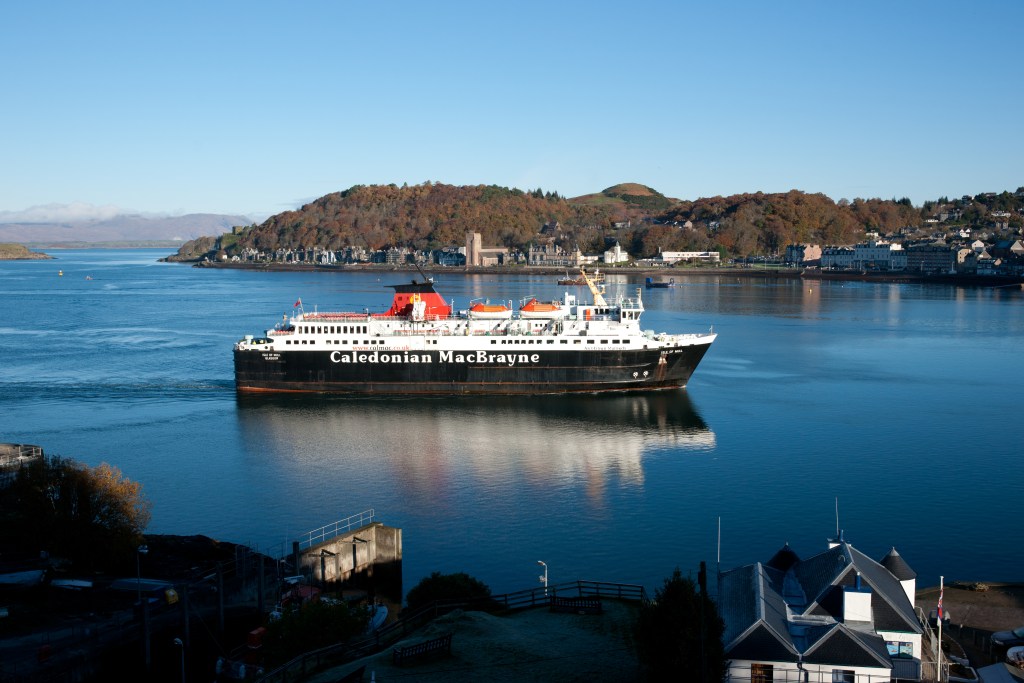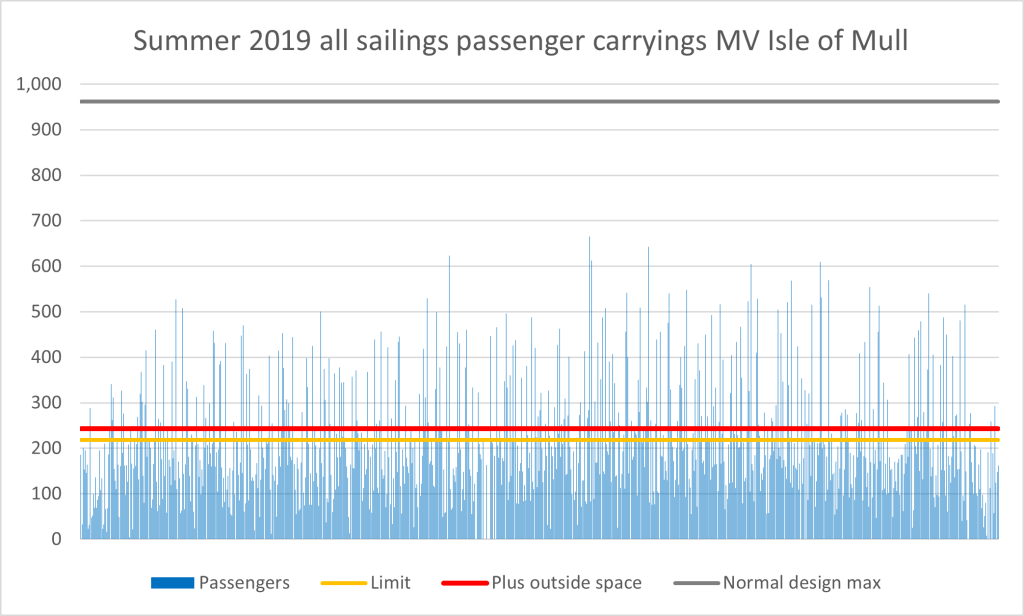With the expected easing of Covid restrictions and the possibility of a busy tourist season ahead, there are concerns that there may not be enough capacity on the ferries to give a space to everyone who wants to travel.
Social distancing rules continue to result in huge reductions in ferry passenger capacity. The MV Isle of Mull for example can currently only carry 243 (including 25 outside only tickets), which is just 25% of her normal 962. The Coruisk can only carry 150; but thanks to her ability to carry passengers in their cars that is a more respectable 60% of her normal maximum. Capacity of 60% is on par with what other ferry operators are achieving under Covid regulations (for example P&O Larne – Cairnryan), but unfortunately CalMac is only achieving 20 – 25% utilisation on its major vessels.

Last summer, these low passenger limits caused few problems. There were far fewer tourists trying to travel. This summer however, things may be different. Domestic travel looks set to be much more open – perhaps even ‘normal’ – and there is potential for this summer season to be a busy one. For tourist businesses and employees who rely on the annual tourist influx, that it certainly what is hoped.

If more normal tourist traffic materialises this summer, and ferry capacity remains so limited, then there may be significant problems. Unfortunately, Transport Scotland do not appear to have recognised this. They have issued a presentation that states “Summer 2021 has sufficient capacity to meet 97% of 2019 summer demand”. This seems to make the highly simplistic assumption that passenger demand is evenly spread across all sailings – ie that just as many people want to travel on the 22:45 from Craignure on a Friday as the 09:55 from Oban on Monday. The assumption appears to be that because total passenger capacity in a day is a little more than the total number of passengers, that there is enough space. It makes no account of how demand varies through the day or week.
The graph below illustrates the issue. It shows 2019 carryings (each blue line is one sailing) against the limits that will be applied this summer on the MV Isle of Mull. Whilst most sailings are under the limit, there are lots above it – and many by a wide margin.

The sailings with high demand are quite predictable – they are those that carry high numbers of day-trippers from Oban, heading for a day out in Tobermory; a visit to Iona Abbey or some time with the puffins on Staffa. To help you see what the impact will be on a typical summer day, below is a graph that averages the passenger carryings for each sailing from June, July & August.

The numbers above are averages – there could be many sailings that would normally carry 5-600 passengers. What is clear however is how little capacity there will be for those busiest day-tripper sailings (particularly 09:50 from Oban and 17:05 from Craignure). It will be very difficult for the typical day tripper to move to a different sailing. Most likely they just will not come.
For tourist businesses and employees that rely on those day-tripping visitors, this could be very painful, after such a disastrous 2020 season. It is very frustrating that thus far, neither CalMac nor Transport Scotland seem to have acknowledged the potential issue.
There are two ways this problem can be fixed –
- Social distancing rules can be relaxed, allowing less separation between passengers. This is obviously in the hands of government and no-one wants to compromise on safety – but hopefully the science may permit relaxation in time for summer.
- The assumptions made regarding the typical size of families and groups that travel together may be re-visited.
The second point is where there is more potential for improvement. Last March when setting the capacity of each vessel, CalMac looked at their ticket data and deduced that the average group size was 1.3. Social distancing is obviously not required between members of the same group (normally a family). Assumptions about the size of typical travelling groups has a direct bearing on ferry capacity, and we believe that the figure of 1.3 is unrealistically low. Particularly for the busiest tourist sailings with a high proportion of family groups, an average group size of 1.3 seems wrong. It may be more realistic for early morning sailings carrying delivery van drivers, but not for the 10am from Oban carrying families for a day out. Our feeling on this was validated by ticket data from many of Mull & Iona’s trip operators, who show that their average group size is more like 2.5.
This is not a safety issue – no one wants to compromise on on-board control measures, so long as they are needed. But it’s important that there is a sound and evidence-led basis to decisions that could have a significant impact on island businesses and employment.
If you have a tourist business that may be affected by this, please email us. We have emailed both Transport Scotland and CalMac on this issue numerous times, but thus far without success. We are arguing that the average group size assumption needs to be re-visited, and ‘Covid safe’ passenger limits adjusted accordingly. If you have a view on this or may be affected, please do get in touch. This issue could impact on the ability of tourists of all kinds to travel (as well of course, as making it more difficult for island residents to get a space).
I’ll finish with a final graph, that shows that the Coruisk will be less affected by this issue – her ‘Covid safe’ limit of 60% is likely to be sufficient for most of her sailings. All minor vessels are generally less badly affected, because (like the Coruisk) passengers can stay in their cars for the crossing.


You fail to mention the lochaline fishnish link
Yes it’s a smaller capacity “Loch” series but with more frequent schedule
We love the Fishnish-Lochaline ferry! Particularly this year, it’s use should be encouraged – there is ample capacity.
Constraint on Lochaline is number of cars as ample passenger accommodation when motorists stay in vehicles. This crossing was frequently ‘full’ Saturdays am ex Mull in 2020 and pm ex Lochaline. Not in favour of any relaxation of social distancing measures but the ‘family’ point in this article is well made and well explained.
What about islanders going over to Oban for hospital appointments.
Hi Gina. CalMac will be keeping a percentage of passenger spaces free for turn-up-and-go like last year, so that sort of eventuality should be covered.
Good day all you hard working folk on this committee. I continue to be grateful for your tireless efforts. Being an island resident of 25 years a single person without a car mostly I am unaffected by most issues. HOWEVER. That most definitely does NOT mean I dont care. Far from it. I have no doubt that the needs, and resident status rights of islanders are right up there with the importance of the absolute need for the preservation of the fragile economy of our islands by the sustainability of tourism. It is all vital. HOWEVER (and I stand corrected) I worry that at the end of the summer all the other bodies involved could just find a way to pluck out figures to justify this current timetable cut and therefore use that as grist to their mill in the argument against the catamaran. Again I say I stand corrected. I am not a committee person but do try to understand all the figures and arguments for and against.
You are all doing a stirling job and I am eternally grateful.
Heather Blaine.
Thankyou Heather!!